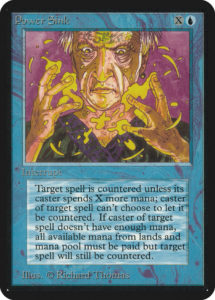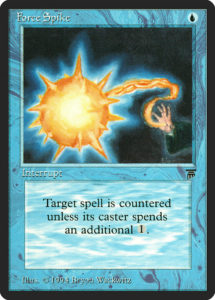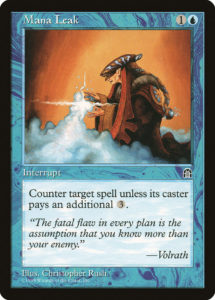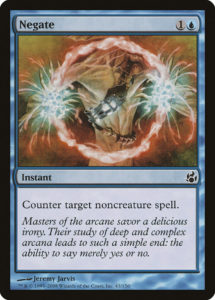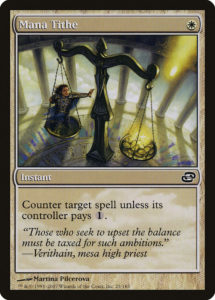With Zendikar Rising preview season beginning, let’s take the moment to revisit one of the most powerful cards in the first Zendikar: the unassuming but potent Spell Pierce.
In the Beginning, Garfield Divided the Countermagic
Spell Pierce is an example of soft taxing countermagic. Soft countermagic isn’t guaranteed to counter every type of spell, while taxing countermagic demands an additional mana investment from your opponent. This is distinct from hard countermagic that is guaranteed to counter a spell (barring shenanigans like uncounterable spells or your opponent having their own countermagic). One might imagine that such restrictions on countermagic would be innovations following the ur-counterspell, Counterspell, however this distinction has existed for as long as Magic has.
Alpha introduced not only Counterspell, but also the splashable (and mana-denying) Power Sink (as well as the worst of the bunch, Spell Blast). These spells introduced a rule that would be mostly followed for all of Magic: hard countermagic required two blue mana while soft countermagic only required one. There’s a bit of blurring between the lines, such as whether Spell Blast is a hard counterspell (since it can counter anything) or a soft counterspell (because it’s really inefficient at countering). But this rule held true (through exceptions like Force of Will) until cards like Ionize changed the rules and allowed multicolor hard counterspells to only require one blue mana.
Legendary Forebears
In Magic’s second year, Spell Pierce‘s oldest direct ancestor appeared. This was Force Spike, the first taxing counterspell with a fixed cost, and the first spell able to counter anything for a mere mana. The relationship between these two counterspells is clear—Force Spike taxes anything for 1, while Spell Pierce taxes about half as much for double the amount.
Legends also introduced Remove Soul, the first counterspell to distinguish between creature and noncreature spells. Alpha had the color-hosing Red Elemental Blast and Blue Elemental Blast; but this was a new blending of soft and hard counterspells, where you were guaranteed to stop a spell—as long as your opponent played along and cast the right type. Interestingly, while Remove Soul was printed back in ’94, the now-ubiquitous and equally elegant Negate wouldn’t be printed until Morningtide in 2008, fourteen years later.
Growing Tax
In 1997, Magic realized that some of its staple effects were simply too strong. Lightning Bolt was the first to go, replaced by Shock. Dark Ritual would soon be completely sunsetted (and its effect color-shifted to red). While Counterspell‘s days weren’t yet numbered in ’97, Tempest’s Mana Leak would eventually replace it. Mana Leak likely has the best flexibility and cost of all the taxing counterspells; while it lacks the raw efficiency and annoyance factor of Force Spike and Mana Tithe, it doesn’t require the perfect set of circumstances in order to function.
1998 brought Null Brooch, the first card to directly counter noncreature spells, beating out Negate by an entire decade. Creatures in 1998 were far less powerful than noncreature spells, but there was no equivalent to Remove Soul. Instead, Magic followed Null Brooch with Stronghold Machinist (a pair with Stronghold Biologist)and Spite // Malice. And, well, that was it for the next decade, at least for noncreature countermagic. Sure, there were no types of innovation, like Prohibit and Daze, but the rest of the groundwork for Spell Pierce would be laid later (and swiftly).
A Conflux of Change
2008-2009 saw a sea change in countermagic. Negate finally saw print fourteen years after Remove Soul had laid the groundwork. For the first time, there was a clean, simple counterpart to Essence Scatter (which has far better flavor than Remove Soul, though it wouldn’t be printed until the following year).
Once this cat was out the bag, there was plenty more to follow. Glen Elendra Archmage came out later that year. 2009 introduced Countersquall and then our hero (or villain, depending on how you feel about counterspells) came onto the scene in Zendikar. From this point on, noncreature countermagic became commonplace. It was available on modal spells (Izzet Charm, Silumgar’s Command, Disciple of the Ring), on new Constructed staples (Stubborn Denial, Force of Negation), and on lackluster Limited cards (Scatter Arc, Unwind).
What Other Paths Await?
It’s fascinating seeing how such a staple effect as Spell Pierce took sixteen years to come to fruition. Sure, the seeds were planted early, but it took a long time to get to where we are today.Spell Pierce‘s release is still closer to now than Magic’s beginning.
It makes one wonder what other staple effects are hiding in plain sight and waiting to be discovered, or what Magic might have looked like if Legends had had Negate instead of Remove Soul. Could we have a Spell Pierce for creatures? Is that sufficiently restrictive that such a spell could also target Planeswalkers, or would “Creature Pierce” so discourage creatures that it couldn’t be printed? What wiggle room is there between Annul and Spell Pierce? Or between Spell Pierce and Miscast? I don’t know, but I’m excited to see what the future has in store and whether Zendikar Rising introduces another new classic counterspell.
And, as always, thanks for reading.
Zachary Barash is a New York City-based game designer and the commissioner of Team Draft League. He designs for Kingdom Death: Monster, has a Game Design MFA from the NYU Game Center, and does freelance gatame design. When the stars align, he streams Magic (but the stars align way less often than he’d like).

